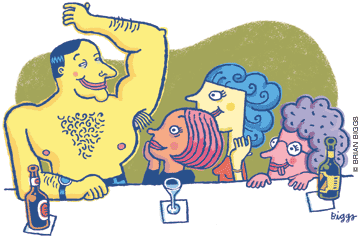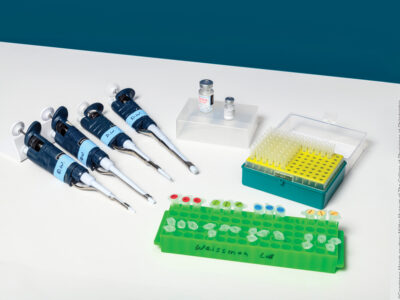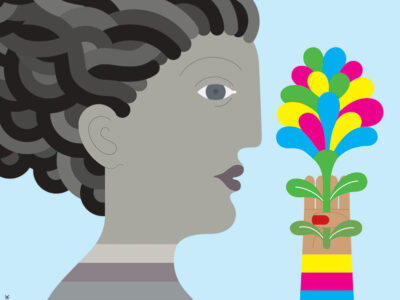
A dab of extract of male underarm perspiration is applied to the upper lip of an ovulating woman. 1. Does she become a) nauseated, b) more tense, c) more relaxed, or d) apoplectic?
Believe it or not, the answer is: c) more relaxed. But there’s a good deal more to it than that.
According to a recent study led by two Penn-connected members of the Monell Chemical Senses Center —Dr. George Preti, adjunct professor of dermatology, and Dr. Charles Wysocki, adjunct professor of animal biology—the scent of male perspiration affects a hormone that regulates the length and timing of the menstrual cycle, and even the woman’s mood. The study—which builds upon earlier findings that female pheromones can affect the menstrual cycles of other women—is the “first to document mood and neuro-endocrine effects of male pheromones on females,” in Preti’s words. It does not, however, identify the chemical compounds that work that particular magic.
“Odors play an important role in mammalian reproductive biology,” Preti and Wysocki write in an article published last month in the journal Biology of Reproduction. “In non-human mammals, chemical signals, known as pheromones, emitted from one animal can cause a variety of changes in behavior and/or physiology” among those who receive those signals. As it turned out, the neuro-endocrine response in women “was not like that of female rodents,” Preti and Wysocki wrote, though “it did rival that seen in goats.”
In the early 1980s, notes Preti, scientists began demonstrating that female underarm secretions can affect the menstrual synchronicity of other women. Though the early studies were controversial, he adds, they “still got people’s attention, and suggested that maybe there is something in the armpits.” More recent studies by Preti and others found that male and female underarm extracts, applied under the noses of females, could alter the length and timing of the menstrual cycle.
“What I wanted to do was get away from measuring cycle length,” says Preti, partly because the lengths are highly variable to begin with. Interested in finding an “endocrine measure,” he wondered: “Could we get an endocrine measure by applying the male extract under the noses of females—as Dr. Wysocki had done in non-human mammals?”
Wysocki suggested they focus on the pulsing of the luteinizing hormone (LH), which is an “excellent” indicator of the release of gonadotropin-releasing hormone (GnRH). The latter hormone’s “positive influence on LH affects the length and timing of the menstrual cycle, which, in turn, affects fertility,” the authors noted, and as ovulation approaches, LH pulses increase in frequency.
Wysocki had another idea: to examine the moods of women under the influence of the male extract. (Each woman, incidentally, was being used as her own control, having been exposed to both the extract and to a control substance.) “Because there was still this undercurrent out there that there are human pheromones that make you feel attractive and sexy and things like that,” notes Preti.
Wysocki then drew up a list of 10 questions for each subject to rate herself, at selected intervals on a scale of 1-7, as energetic, sensuous, tense, tired, calm, sexy, anxious, fatigued, relaxed, and active. The subjects themselves were 18 “ovulating, heterosexual women,” age 25-45.
Despite the oddly exotic-sounding nature of the subject, the study was carefully crafted. For one thing, the extract itself (carefully collected and controlled for bacteria from the un-deodorized armpits of several male volunteers) was mixed together to form a sort of “super-male” scent that cancelled out individual qualities. The extract was adjusted—and diluted—so that all applications were essentially equal. Finally, a “deodorant fragrance” was added to disguise the nature of the product. (For the control, they used ethanol to dilute a perspiration-free fragrance.) “None correctly guessed the true nature of the stimuli that were being delivered to their nasal region,” Preti and Wysocki wrote. “All subjects perceived ‘alcohol’ and/or ‘fragrance.’” That, they noted, suggests that “conscious awareness of body odor is not necessary to elicit the primer and modulator pheromonal responses” that were observed.
Or, as Wysocki put it: “there may be much more going on in social settings like singles bars than meets the eye.”
The results revealed a shift in blood levels of LH, produced by pulses by the pituitary gland, which normally surge right before ovulation. Exposure to the “male axillary extract,” the authors wrote, “shortened the time to the next LH pulse by an average of 20 percent.” In other words, it helped hasten ovulation.
“If you have a bonded couple and you want to create the optimum scenario for fertility and procreation of the species,” says Preti, “you’re going to have the odor of one [member of the couple] affecting the other in a way that optimizes the fertile situation—so they can pass their genes along.”
Of course, procreation of the species depends on more than just hormones and ovulation. Which leads to those moods.
Compared with the control fragrance, the women were “less tense and more relaxed during exposure to the male extract,” Preti and Wysocki noted. But none of the other moods registered change.
Given the clinical setting, it’s hardly surprising that the women didn’t report feeling more sensual or sexy. But, says Wysocki: “It is fair enough to say that if a woman is less tense and more relaxed, it’s easy to see how things can become more sensual.”
“From a broader evolutionary perspective, women have to be attuned to any signals coming in that might influence their reproductive efforts,” adds Preti. “The bottom line of our story is, humans do produce pheromones. But they’re not the sex-enhancer of folklore.”
They are now looking at the many individual compounds that make up male perspiration to determine which may be responsible for the cyclical and emotional changes.
“This may open the door to pharmacological approaches to manage onset of ovulation or the effects of premenstrual syndrome or even natural products to aid relaxation,” Wysocki said. “By determining how pheromones impact mood and endocrine response, we might be able to build a better male odor: molecules that more effectively manipulate the effects we observed.”
“A lot of guys in chemistry look at tree bark and sea sponges and sea anemones and all kinds of weird animals for natural product sources,” says Preti. “Just think of the underarm as a natural product source—and one of the natural products it has is a natural mood enhancer and an endocrine regulator that we’ve been exposed to for a few hundred thousand years.”




